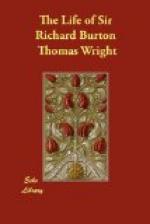[FN#61] The Tota-kahani is an abridgment of the Tuti-namah (Parrot-book) of Nakhshabi. Portions of the latter were translated into English verse by J. Hoppner, 1805. See also Anti-Jacobin Review for 1805, p. 148.
[FN#62] Unpublished letter to Mr. W. F. Kirby, 8th April 1885. See also Lib. Ed. of The Arabian Nights, viii., p. 73, and note to Night V.
[FN#63] This book owes whatever charm it possesses chiefly to the apophthegms embedded in it. Thus, “Even the gods cannot resist a thoroughly obstinate man.” “The fortune of a man who sits, sits also.” “Reticence is but a habit. Practise if for a year, and you will find it harder to betray than to conceal your thoughts.”
[FN#64] Now it is a town of 80,000 inhabitants.
[FN#65] Sind Revisited, i. 100.
[FN#66] “The first City of Hind.” See Arabian Nights, where it is called Al Mansurah, “Tale of Salim.” Burton’s A. N., Sup. i., 341. Lib Ed. ix., 230.
[FN#67] Mirza=Master. Burton met Ali Akhbar again in 1876. See chapter xviii., 84.
[FN#68] Yoga. One of the six systems of Brahmanical philosophy, the essence of which is meditation. Its devotees believe that by certain ascetic practices they can acquire command over elementary matter. The Yogi go about India as fortune-tellers.
[FN#69] Burton used to say that this vice is prevalent in a zone extending from the South of Spain through Persia to China and then opening out like a trumpet and embracing all aboriginal America. Within this zone he declared it to be endemic, outside it sporadic.
[FN#70] Burton’s Arabian Nights, Terminal Essay, vol. x. pp. 205, 206, and The Romance of Isabel Lady Burton, by W. H. Wilkins, ii., 730.
[FN#71] Married in 1845.
[FN#72] She died 6th March 1846, aged 74.
[FN#73] He died 5th October 1858. See Sind Revisited, ii. 261.
[FN#74] Camoens, born at Lisbon in 1524, reached Goa in 1553. In 1556 he was banished to Macao, where he commenced The Lusiads. He returned to Goa in 1558, was imprisoned there, and returned to Portugal in 1569. The Lusiads appeared in 1572. He died in poverty in 1580, aged 56.
[FN#75] The Arabian Nights.
[FN#76] Who was broken on the wheel by Lord Byron for dressing Camoens in “a suit of lace.” See English Bards and Scotch Reviewers.
[FN#77] Begun at Goa 1847, resumed at Fernando Po 1860-64, continued in Brazil and at Trieste. Finished at Cairo 1880.
[FN#78] Napier was again in India in 1849. In 1851 he returned to England, where he died 29th August 1853, aged 71.
[FN#79] Life of Sir Charles Napier, by Sir W. Napier.
[FN#80] The Beharistan, 1st Garden.
[FN#81] She married Col. T. Pryce Harrison. Her daughter is Mrs. Agg, of Cheltenham.
[FN#82] She died 10th September 1848, and is buried at Elstree.
[FN#83] Elisa married Colonel T. E. H. Pryce.




